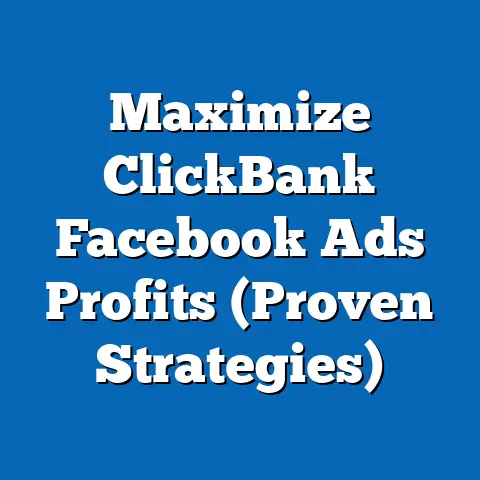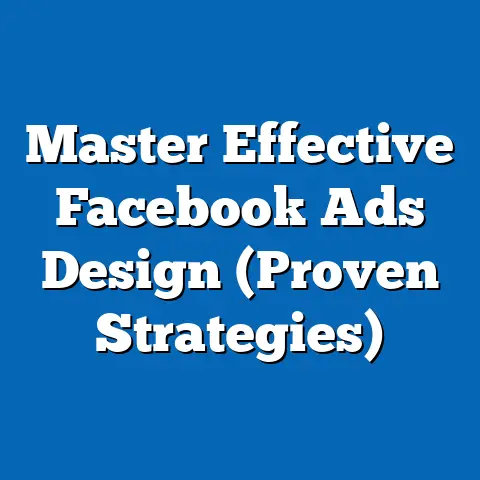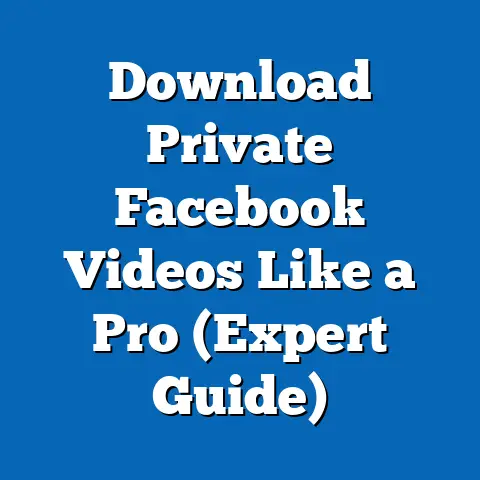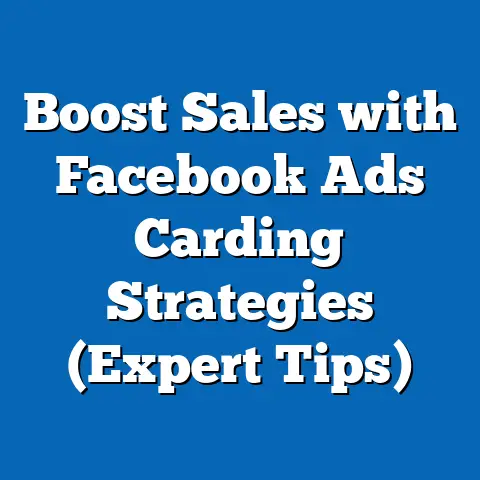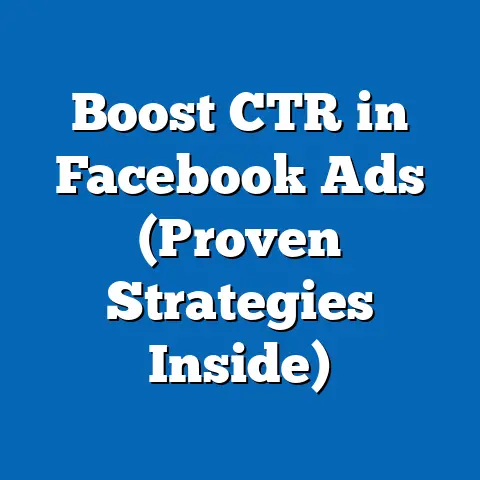Why Is My Facebook Ad Paused? (Unlock Insights Now)
Have you ever felt that surge of excitement when your Facebook ad campaign finally starts gaining traction? The clicks are rolling in, leads are trickling through, and you can almost taste the sweet victory of a successful campaign. Then, BAM! You log in one morning, ready to bask in the glory, only to be met with the dreaded “Paused” status. It’s like a punch to the gut, isn’t it?
I remember launching a campaign for a local bakery a few years back. The ads were beautifully designed, the targeting was laser-focused, and the initial results were promising. We were promoting their new line of artisan breads, and people were drooling over the images. I was practically doing a happy dance in my office. Then, out of nowhere, the ads stopped running. My heart sank. Was it a technical glitch? Had I accidentally hit the wrong button? Or worse, was there something fundamentally wrong with the ad itself? The confusion was overwhelming, and the anxiety started creeping in. I spent hours scouring Facebook’s help center, desperately trying to figure out what went wrong. It felt like I was wandering in the dark, completely clueless. I knew I had to figure it out, not just for the bakery, but for my own peace of mind. That experience, while frustrating, ignited my passion for understanding the intricacies of Facebook’s ad platform. It’s a journey that’s led me to uncover the common pitfalls and best practices that can make or break a campaign. So, if you’ve ever felt the sting of a paused Facebook ad, know that you’re not alone. And more importantly, know that there are answers. Let’s dive in and unlock the secrets behind those pesky pauses!
Understanding Facebook Ads
Before we delve into the nitty-gritty of why your Facebook ad might be taking an unexpected break, let’s establish a solid foundation of what Facebook Ads actually are and why they’re such a vital tool in the digital marketing arsenal.
Facebook Ads, at their core, are paid advertisements displayed on the Facebook and Instagram platforms (both owned by Meta). These ads come in various shapes and sizes, catering to different objectives and target audiences. Think of them as strategically placed billboards in the digital world, designed to capture attention and drive action.
Here’s a quick rundown of some of the most popular Facebook Ad formats:
- Image Ads: The simplest format, featuring a single image with accompanying text. These are great for showcasing products or services with visually appealing imagery.
- Video Ads: Engaging ads that use video to tell a story or demonstrate a product. They tend to capture attention more effectively than static images.
- Carousel Ads: Allow you to display multiple images or videos in a single ad, each with its own headline, description, and link. Perfect for showcasing a range of products or highlighting different features of a single product.
- Collection Ads: Designed for mobile shoppers, these ads feature a hero image or video followed by a selection of related products.
- Lead Ads: Capture leads directly within the Facebook platform, making it easy for users to sign up for newsletters, request quotes, or download resources.
- Slideshow Ads: Create a video-like experience using a series of images or videos. These are great for marketers who don’t have the resources to produce high-quality video content.
So, why are Facebook Ads so important? Well, for starters, Facebook boasts a massive user base, making it a prime location to reach a vast and diverse audience. According to recent statistics, Facebook has over 2.9 billion monthly active users, offering unparalleled reach for businesses of all sizes.
But it’s not just about sheer numbers. Facebook Ads also offer incredibly precise targeting capabilities. You can target users based on demographics, interests, behaviors, and even custom audiences created from your own customer data. This level of granularity allows you to reach the people who are most likely to be interested in your products or services, maximizing your advertising ROI.
The primary goals associated with running Facebook Ads are diverse, but often revolve around:
- Brand Awareness: Increasing the visibility of your brand and reaching a wider audience.
- Lead Generation: Capturing contact information from potential customers who are interested in your products or services.
- Website Traffic: Driving traffic to your website to increase engagement and potential conversions.
- Sales: Promoting products or services directly to drive sales and revenue.
- Engagement: Encouraging users to interact with your content, such as liking, commenting, and sharing.
In essence, Facebook Ads are a powerful tool that can help you achieve a wide range of marketing objectives. But like any powerful tool, they require a certain level of understanding and expertise to use effectively. And that’s where understanding why your ad might be paused comes into play.
Key Takeaway: Facebook Ads are a versatile and powerful tool for reaching a massive audience with precise targeting capabilities. Understanding the different ad formats and common goals is crucial for creating effective campaigns.
Common Reasons for Paused Ads
Now, let’s get to the heart of the matter: why your Facebook ad might be taking an unexpected timeout. There are several common culprits, and understanding them is the first step in getting your campaign back on track.
Ad Approval Issues
Facebook has a comprehensive set of advertising policies that all ads must adhere to. These policies are designed to protect users and maintain a positive experience on the platform. Unfortunately, even the most well-intentioned marketers can sometimes run afoul of these guidelines.
Common violations that can lead to paused ads include:
- Inappropriate Content: Ads that contain offensive, discriminatory, or sexually suggestive content are strictly prohibited.
- Misleading Information: Ads that make false or exaggerated claims, or that deceive users in any way, will be rejected.
- Prohibited Products: Facebook prohibits the promotion of certain products and services, such as firearms, tobacco, and illegal drugs.
- Health and Medical Claims: Ads that make unsubstantiated health claims or promote potentially harmful medical treatments are heavily scrutinized.
- Personal Attributes: Ads that directly target or discriminate against individuals based on their race, ethnicity, religion, gender, age, sexual orientation, or other personal attributes are strictly forbidden.
I’ve seen ads get flagged for the most unexpected reasons. Once, I was running a campaign for a travel agency promoting a trip to Italy. The ad featured a beautiful image of the Colosseum, but it was flagged because Facebook’s algorithm mistakenly identified it as a “political monument.” It took a few appeals to get the ad approved, but it highlights the importance of understanding Facebook’s policies and being prepared to defend your ads.
Budget Constraints
This one might seem obvious, but it’s a surprisingly common reason for paused ads. If you run out of budget or exceed your daily spending limit, Facebook will automatically pause your ad to prevent you from overspending.
It’s crucial to monitor your budget closely and ensure that you have sufficient funds available to keep your ads running. You can set daily budgets or lifetime budgets, depending on your campaign goals and preferences. I personally prefer using daily budgets as it gives me more control and flexibility to adjust spending based on performance.
Targeting Issues
While Facebook’s targeting capabilities are a major strength, they can also be a source of problems if not used correctly. Overly restrictive targeting can limit your ad delivery, causing it to pause.
For example, if you target a very specific demographic with a narrow set of interests, you might be excluding a large portion of your potential audience. Facebook’s algorithm needs a certain amount of data to optimize your ad delivery, and if your audience is too small, it might struggle to find the right people.
I once worked with a client who was targeting only users who had expressed interest in a very niche hobby. While their intentions were good (they wanted to reach the most qualified prospects), their audience was so small that their ads barely got any impressions. By broadening their targeting to include related interests, we were able to significantly increase their reach and engagement.
Changes in Campaign Settings
Unintentional changes in campaign settings, such as audience adjustments or ad placements, can also impact ad performance and lead to ad pauses.
For example, if you accidentally exclude a key demographic from your audience or remove a high-performing ad placement, you might see a sudden drop in performance, which could trigger Facebook’s algorithm to pause your ad.
It’s essential to review your campaign settings regularly and ensure that everything is configured correctly. I recommend keeping a log of any changes you make to your campaigns, so you can easily revert back to previous settings if necessary.
Account Status
Finally, issues with your ad account, such as payment failures or policy violations, can result in ad pauses.
If your payment method is declined or your account is flagged for violating Facebook’s advertising policies, your ads will be automatically paused until the issue is resolved.
It’s crucial to keep your payment information up to date and to address any policy violations promptly. Facebook typically provides notifications and warnings when your account is at risk, so be sure to monitor your account health regularly.
Key Takeaway: Understanding the common reasons for paused ads, such as ad approval issues, budget constraints, targeting issues, changes in campaign settings, and account status, is crucial for preventing future pauses and maintaining consistent ad performance.
How to Diagnose Why Your Ad is Paused
Now that we’ve covered the common reasons for paused ads, let’s talk about how to diagnose the specific issue affecting your campaign. Fortunately, Facebook provides a range of tools and resources to help you pinpoint the problem and get your ads back on track.
Ad Manager Insights
The first place to start your investigation is the Facebook Ads Manager. This is your central hub for managing all of your ad campaigns, and it provides valuable insights into the status of your ads.
To check the status of your ad, navigate to the “Ads” tab in Ads Manager. Here, you’ll see a list of all of your active and paused ads. The “Delivery” column will indicate the status of each ad. If an ad is paused, you’ll see a “Paused” label along with a reason for the pause.
Pay close attention to any notifications or alerts displayed in Ads Manager. These notifications often provide specific details about why your ad was paused and what steps you can take to resolve the issue.
You can also review the “Performance” metrics for your ad to see if there were any sudden drops in performance that might have triggered the pause. Look for metrics such as impressions, clicks, and conversions. If you see a significant decline in these metrics, it could indicate a problem with your targeting, creative, or landing page.
Review Ad Feedback
Facebook provides feedback on your ads, including any messages regarding policy violations or performance issues. This feedback can be invaluable in understanding why your ad was paused.
To review ad feedback, navigate to the “Ad Quality” section in Ads Manager. Here, you’ll see a list of all of your ads and their corresponding quality scores. If an ad has a low-quality score, it could indicate a problem with the ad’s relevance or user experience.
Facebook also provides detailed feedback on specific policy violations. If your ad was flagged for violating a particular policy, you’ll see a message explaining the violation and providing instructions on how to correct it.
It’s essential to take this feedback seriously and make the necessary changes to your ad to ensure that it complies with Facebook’s policies. Ignoring this feedback could result in further penalties, such as account suspension.
Check Account Health
Finally, assess the overall health of your ad account, including payment settings, account standing, and past performance metrics.
To check your account health, navigate to the “Account Quality” section in Ads Manager. Here, you’ll see a summary of your account’s standing, including any outstanding payments or policy violations.
Ensure that your payment information is up to date and that your account is in good standing. If you have any outstanding payments or policy violations, resolve them promptly to prevent further disruptions to your ad campaigns.
You can also review your account’s past performance metrics to identify any trends or patterns that might be contributing to your ad pauses. For example, if you consistently run ads that violate Facebook’s policies, your account might be flagged for review, which could result in more frequent ad pauses.
Key Takeaway: Diagnosing the reason for your ad pause involves checking Ad Manager insights, reviewing ad feedback, and assessing your account health. By carefully examining these areas, you can pinpoint the problem and take corrective action.
Strategies for Preventing Future Pauses
Prevention is always better than cure, and that’s especially true when it comes to Facebook Ads. By implementing a few key strategies, you can minimize the risk of your ads being paused and ensure consistent performance.
Best Practices for Ad Creation
Creating compliant ads that align with Facebook’s advertising policies is crucial for preventing ad pauses. Here are a few guidelines to follow:
- Use High-Quality Imagery: Ensure that your images are clear, relevant, and visually appealing. Avoid using stock photos that look generic or staged.
- Write Clear and Concise Copy: Use clear and concise language that accurately describes your product or service. Avoid making false or exaggerated claims.
- Be Transparent About Pricing: Clearly disclose your pricing and any associated fees. Avoid using hidden fees or misleading pricing tactics.
- Target the Right Audience: Use Facebook’s targeting options to reach the people who are most likely to be interested in your product or service. Avoid targeting overly broad or narrow audiences.
- Follow Facebook’s Advertising Policies: Familiarize yourself with Facebook’s advertising policies and ensure that your ads comply with all applicable guidelines.
I always recommend creating a checklist of these best practices and reviewing it before submitting any ad for approval. It’s a simple step that can save you a lot of headaches down the road.
Budget Management
Effective budget management is essential for preventing your ads from being paused due to insufficient funds. Here are a few tips to keep in mind:
- Set Realistic Budgets: Set budgets that are aligned with your campaign goals and available resources. Avoid setting budgets that are too low or too high.
- Monitor Your Spending: Monitor your spending closely and make adjustments as needed. Use Facebook’s reporting tools to track your ad performance and identify areas where you can optimize your spending.
- Use Daily Budgets: Consider using daily budgets to control your spending and prevent you from exceeding your budget too quickly.
- Top Up Your Account Regularly: Ensure that you have sufficient funds in your account to cover your ad spending. Set up automatic payments to avoid running out of funds unexpectedly.
I personally use a spreadsheet to track my ad spending and project my future budget needs. It’s a simple but effective way to stay on top of my finances and prevent any surprises.
Regular Monitoring
Regularly checking your ad performance and making necessary adjustments to targeting and settings is crucial for maintaining consistent ad performance.
Set aside time each week to review your ad campaigns and identify any areas that need improvement. Look for trends in your data and make adjustments to your targeting, creative, or bidding strategies as needed.
Don’t be afraid to experiment with different approaches to see what works best for your audience. Facebook’s algorithm is constantly evolving, so it’s important to stay agile and adapt your strategies accordingly.
Key Takeaway: Preventing future pauses requires following best practices for ad creation, implementing effective budget management strategies, and regularly monitoring your ad performance.
Remember, Facebook advertising can be a powerful tool for reaching your target audience and achieving your marketing goals. But it requires a certain level of understanding and expertise to use effectively.
By understanding the reasons behind ad pauses and taking proactive steps to prevent them, you can ensure that your campaigns run smoothly and consistently, delivering the results you’re looking for.
I encourage you to take the insights provided in this article and apply them to your own Facebook ad campaigns. Don’t be afraid to experiment, learn from your mistakes, and adapt your strategies as needed.
With a little bit of knowledge and effort, you can master the art of Facebook advertising and unlock the full potential of this powerful platform. Now, go forth and conquer the world of Facebook Ads!

